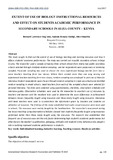| dc.contributor.author | Ong’amo, B. L. | |
| dc.contributor.author | Ondigi, S. R. | |
| dc.contributor.author | Omariba, Alice | |
| dc.date.accessioned | 2019-09-03T12:59:40Z | |
| dc.date.available | 2019-09-03T12:59:40Z | |
| dc.date.issued | 2017-07 | |
| dc.identifier.issn | 2411-2933 | |
| dc.identifier.uri | http://hdl.handle.net/123456789/4346 | |
| dc.description | Vol:-5 No-07, 2017 | en_US |
| dc.description.abstract | This study sought to find out the extent of use of biology teaching and learning resources and how it
affects students’ academic performance. The study was carried out in public secondary schools in Siaya
County. The researcher used a sample of twenty-three schools drawn from ninety two public secondary
schools selected through stratified random sampling. Teacher respondents were purposively or randomly
sampled. Purposive sampling was used to choose the most experienced biology teacher from two or
more teachers teaching form two classes. Where there existed more than one long serving and
experienced teachers teaching form two classes, random sampling was employed to pick one of them for
interview. Student respondents were chosen through random sampling in single sex schools and stratified
random sampling in mixed schools. Head teachers from each of the sampled schools were selected for
personal interview. The data were collected using questionnaires, checklists, observation schedules and
interview guides. Observation schedules were used by the researcher to ascertain use of resources by
teachers and learners and the resultant tests used to determine the score differences in achievement
between classes frequently taught using resources and those rarely taught using resources. Interviews
with head teachers were used to countercheck the information given by teachers and students on
utilization of resources. The findings of the study established that audio-visual resources were least used
in schools. The resources were mainly bought by the headteachers. The researcher’s assessment during
live lesson teaching using observation schedules showed that students frequently taught using resources
performed better than those rarely taught using the resources. The research also established that
frequent use of resources was not the only factor determining high student’s academic performance but
other factors like teacher’s qualification, pedagogy, attitudes and students’ entry behaviour also played a
role in realizing improved academic performance in students. | en_US |
| dc.language.iso | en | en_US |
| dc.publisher | International Journal for Innovation Education and Research | en_US |
| dc.subject | Individualized learning, Inductive learning, Teaching resource, Hands on activities | en_US |
| dc.title | Extent of Use of Biology Instructional Resources and Effect on Students Academic Performance in Secondary Schools in Siaya County – Kenya | en_US |
| dc.type | Article | en_US |

